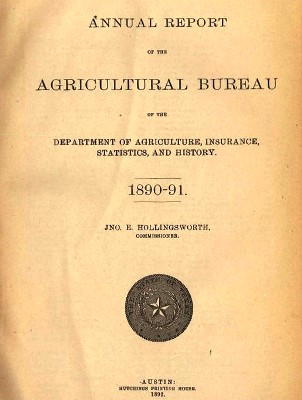|
production on the Williams farmstead would certainly have varied from year to year, with drought years being the least productive. However, using the average productivity data for Williams’ farming neighbors in 1880 does provide a reasonable proxy for what Williams was doing on his farm in the 1880s and 1890s. The 1880 crop yields per acre for the Antioch Colony and Bear Creek farmers were as follows:
COTTON: Average yield was 0.3 bales/acre for both Antioch Colony and Bear Creek
CORN: Average yield was 11.2 bushels/acre for Antioch Colony and to 12.5 bushels/acre for Bear Creek
We then calculated the productivity of cotton and corn on the Williams farmstead as follows:
COTTON: 10.5 acres x 0.3 bales/acre = 3.15 bales produced
CORN: 7 acres x 11.2 to 12.5 bushels/acre = 78.4 to 87.5 bushels produced
We then used the 1890–1891 Texas Agricultural Bureau report to calculate crop prices as follows:
COTTON:
Hays County = $50.04 per bale
Travis County = $43.83 per bale
CORN:
Hays County = $0.51 per bushel
Travis County = $0.98 per bushel
The final step in this exercise was estimating the total sales price for all the cotton and surplus corn that Ransom Williams produced annually. Although we do not know the exact place(s) where Ransom would have sold his cotton and corn in the 1880s and 1890s, he undoubtedly would have sold it locally in Travis or Hays Counties. Living so close to the county line, Ransom probably had equal access to markets in both counties, and he would likely have sold his produce wherever he could get the highest price in any given year. The estimated total amount of income from Ransom Williams’ cash crops is as follows:
COTTON: Sale of 3.15 bales of cotton at $43.83 to $50.04 per bale = $138.06 to $157.26
CORN: Sale of 33.6 to 43.8 bushels (one half of total corn produced)
at $0.51 to $0.98 per bushel = $17.14 to $42.92
This mathematical exercise leads us to the following conclusion: If the Williams farmstead operation was similar to that of his fellow freedmen in Antioch Colony and his white neighbors in the Bear Creek area, Ransom Williams could have made between $155.20 and $200.18 annually from the production and sale of cash crops in a good year. We can imagine that as much as one-half to three-quarters of this annual income was spent on consumable goods (such as food, medicine, tobacco, ammunition), durable goods (cloth and buttons for making work clothes, farm tools, equipment and parts), and other necessities. The remaining money, which could be as little as $38.80 and as much as $100.09, was discretionary money. The calculations above do not take into account any additional forms of income from outside works or odd jobs performed by Ransom, Sarah, or any of the children. Ransom may have used his wagon to deliver water to his neighbors, worked as a farrier, or made some extra cash repairing firearms. Sarah could have brought in some cash as a seamstress, doing small sewing jobs for neighbors or friends at church. During the cotton or corn harvest, any of the family members could have hired on to help local farmers bring in their crops.
The discretionary money represents the net profit that Ransom and Sarah Williams made from their successful farming operation after subtracting their operating expenses and essential purchases. This extra money, perhaps as much as $100 in a good farming year, represented a significant amount of buying power in the late nineteenth century. For Ransom and Sarah Williams, it represented the ability to purchase a few luxuries for themselves and their children, and a chance for them to participate in the great American dream. |
